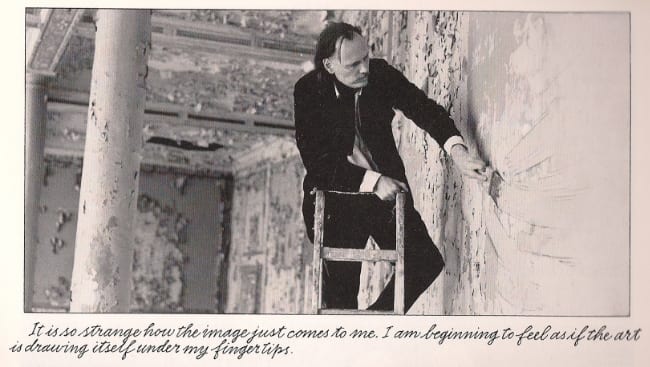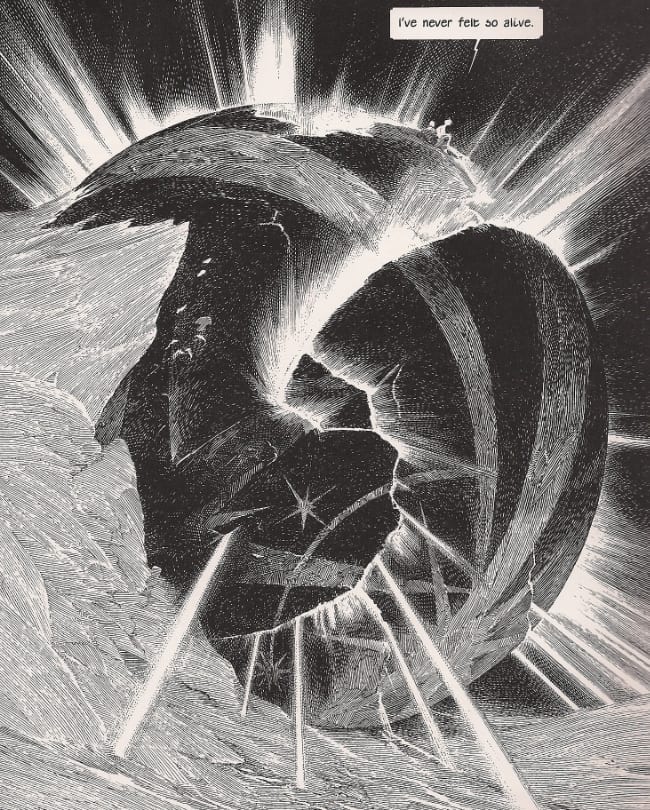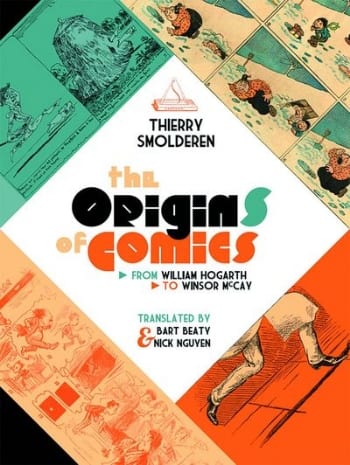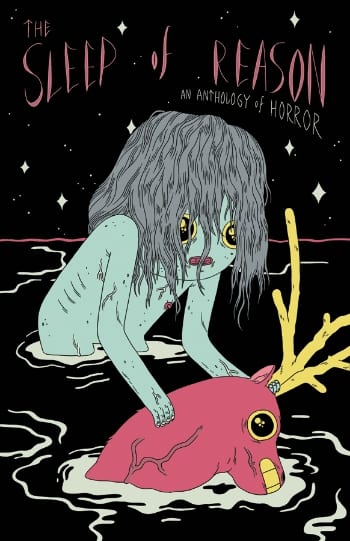I'm always pleased to see a crowdfunded comic successfully appear, and no Kickstarter campaign was more interesting to me last year than that of Alaxis Press, which sought to translate and publish Les Cités obscures - the longtime work of artist François Schuiten and writer Benoît Peeters, a series of strange journeys and morality plays set among towering works of imaginary city architecture. They are truly unlike any other comics in the world, yet even while Japanese translations won the Grand Prize for Manga at the 2012 Japan Media Arts Festival, what few volumes of the Obscure Cities that even found themselves translated languished in out of print NBM editions, not popular enough to be financially viable yet in-demand enough to keep prices high.
With a logo designed by Schuiten himself, Alaxis at least carries itself with the dignity of authorization. Better still, having met its $30,000.00 campaign goal, the publisher has announced a whole line of translations stretching all the way through 2014, though the Kickstarter itself functioned pragmatically for many as a means of pre-ordering the first of the releases: 1996's The Leaning Girl, available as both a limited hardcover (with which I am not familiar) and a sturdy 176-page softcover, 9.5" x 11.75" and rather heavy - comparable in production values to First Second's '09 release of Guibert & co.'s The Photographer.
Hopefully it will be available to non-backers soon, as it is quite a strong work. Not only is Schuiten in fine form -- detailing the dreams of young Mary von Rathen in full, warm color before delineating her waking life in a lavish b&w reminiscent of wood engraving -- but he is joined by two visual collaborators: Marie-Françoise Plissart, who had worked with writer Peeters before on books of photographic narratives, and Martin Vaughn-James, author of one of the most obscure (and, perhaps thus, most fervently-adored) of the 1970s proto-graphic novels, The Cage, who was painting in Belgium at the time and found himself tasked with 'starring' in Plissart's photo sequences, which depict scenes taking place in the twilight of the 19th century in 'our' world, as opposed to the drawn, imaginary world of the Obscure Cities. Indeed, what appear to be several of Vaughn-James' own paintings are showcased in these sequences, which ultimately inform the look of Schuiten's pages, so it might be further imagined that the older artist wields a yet-heavier influence, even as Plissart shoots against as many white backgrounds as possible, offering a high-contrast suggestion of human meat as only more detailed ink splotched against a similar page.
I will not attempt a full review of this book in such limited space. However, the unique circumstances of the compositional makeup of The Leaning Girl do stoke my curiosity as to one particular aspect of the Obscure Cities project: frankly, its sexuality. Emphasizing so much the quality of fantasy, of imagining, of discovering special, hidden places in the everyday, as if passage to this parallel world could be accomplished by simply turning the right corner, there would inevitably have to be an erotic character as well. Yet for all the magnificent flights of fancy discernible from Schuiten's bygone towers and urban grids, the sexual imagination evidenced by himself and Peeters, at least in the volumes translated to English over the years, is rather startlingly vanilla. Always, there is a driven or obsessed male protagonist -- often an older man, into middle age and beyond -- and he always seems to fall into liaisons with a women of fairly buxom physical character, often working at cross-purposes, and sometimes noticeably younger than him.
As you can discern from its title, however, The Leaning Girl has a female protagonist: young Mary, who, upon visiting a grand exposition with her conservative family, becomes afflicted with a strange tendency to lean to one side. Indeed, she cannot remain on her feet if she stands 'straight' - as tidy a metaphor as can be concocted for a spirited girl who won't abide the roles set out for her by local society. The book follows her journey over the course of half a decade, as she ventures past the cusp of womanhood, and experiences new and even less-desired attention, as illustrated just above: lecherous scientists, who -- in an ongoing subplot -- have been attempting to solve the mystery of a phantom planet that has perched itself somewhere outside of the Earth's atmosphere. The most romantic and fanciful of them, Wappendorf, eventually cannot restrain himself from plotting a Georges Méliès-style trip to this new moon.
***BE AWARE, SPOILERS NOW FOLLOW. SEXY ONES. SKIP DOWN TO THE SHOPPING LIST IF YOU DON'T WANT 'EM***
Of course, Mary comes with him, and of course, this faraway world is the place where she can best navigate the terrain. She is utterly delighted, and it must be said that Peeters gives her delight an interestingly cruel tinge, as her departure for this new world is marked by the death of her gruff but loving father, about whom she genuinely does not seem to especially care. Meanwhile, Vaughn-James -- who has spent the majority of his subplot moaning about the cruelty of art critics, despite having demonstrably abandoned anything resembling a loved one to chase unfettered rebel creativity -- has found a portal into the Unknown Place, and everybody who has seen the Ralph Bakshi motion picture Cool World knows what's bound to happen: the excitable Mary (whose evidently photo-referenced-at-times state suddenly seems all part of the plan) pretty much throws herself at the errant, now-drawn-by-Schuiten painter.
It could certainly be handled more smoothly. Mary doesn't seem to have any sexual identity until just then, although it wouldn't be unexpected for her to keep things close to her heart, or even lash out in sudden performance of adulthood. We are not told her exact age, but I think it's safe to place it at "worryingly young," which gives the liaison with the over-50 Vaughn-James, so similar to earlier Obscure Cities pairings, a rightly creepy feel, particularly as Schuiten turns his formidable powers toward detailing her nude breasts, her pubic hair - her mouth kissing his hand. But even in her secret garden, Mary is denied agency. Vaughn-James & Wappendorf commiserate over the fate of the dimensions, and make adult, paternalistic decisions to withdraw from the Unknown Place, leaving Mary wailing in frustration once again.
"And then," she writes, omnisciently, "I had to grow up."
The various denouements of The Leaning Girl are startling in their shift in perspective. Both of the adult men -- dreamers and creatives both -- are depicted as having lost their artsy edge, and proving themselves utterly incapable of contribution to society. Vaughn-James, the damnable manchild, wanders away into total obscurity, lamenting his separation from Mary, whom he had fancied a muse. Wappendorf, elsewhere, attends a city function where the now-older Mary has proven herself a major player in the good of civics. "...in all these years, I haven't invented a single vehicle," he confesses, though Mary, who has totally stopped leaning, holds no grudge. She has bigger things on her mind. The faraway place was a realm of fancy and delight, but Schuiten, Peeters, Plissart & Vaughn-James depict it as a zone where people cannot entirely live. The pretentious and self-justifying 'creative' men of the book are mocked for the meagerness of their pursuits in the face of community good, while Mary knew the place fully as a girl, and understood she could not remain a girl. It is nice to find hidden cities, these accomplished fantasists say, but, bourgeois as may sound, you really do need to be a fucking adult.
***
PLEASE NOTE: What follows is not a series of capsule reviews but an annotated selection of items listed by Diamond Comic Distributors for release to comic book retailers in North America on the particular Wednesday identified in the column title above. Be aware that some of these comics may be published by Fantagraphics Books, the entity which also administers the posting of this column. Not every listed item will necessarily arrive at every comic book retailer, in that some items may be delayed and ordered quantities will vary. I have in all likelihood not read any of the comics listed below, in that they are not yet released as of the writing of this column, nor will I necessarily read or purchase every item identified; THIS WEEK IN COMICS! reflects only what I find to be potentially interesting.
***
SPOTLIGHT PICKS!
The Origins of Comics from William Hogarth to Winsor McCay: And finally-- er, firstly, your book-on-comics for the week, as anticipated an academic work as I can recall in recent years - the new one from Thierry Smolderen, BD writer and website impresario. Translated by Bart Beaty & Nick Nguyen from the 2009 French original, this University Press of Mississippi release finds Smolderen reading "the picture stories, caricatures, and humoristic illustrations of William Hogarth, Rodolphe Töpffer, Gustave Doré, and their many contemporaries," as a means of identifying the continuum, which, spurred by technological advances, brought "comics" into the state by which it is typically defined. A 200-page hardcover, 9" x 12", with illustrations in b&w and color; $50.00.
The Sleep of Reason: But we cannot ignore Kickstarter for long, as it has also helped realize this 360-page anthology from Iron Circus Comics. Beneath the Michael DeForge cover are stories of horror designed to avoid the typical tropes and formulas with which we're all familiar, drawn by a diverse array of talents including Carla Speed McNeil, Gabby Schulz, KC Green and many others. Worth peering through, I'll bet. List of contributors; $30.00.
--
PLUS!
Hidden: A Child's Story of the Holocaust: Being the newest release from First Second, which has made translations from the French part of its publishing persona from the very beginning, this is a 7" x 9" hardcover edition of a 2012 work from writer Loïc Dauvillier and artists Marc Lizano (lines) & Greg Salsedo (colors). It's an 80-page account of persecution and compassion in Paris in a very dark time; $16.99.
The Harlem Hellfighters: But if it's not history First Second-style you're after - oh man. A cooperative endeavor between publisher Broadway Books (an imprint of the Crown Publishing Group, a division of Random House, Inc.) and packager Avatar Press (America's line-leader in "Fatal Fantasy" variant covers), this 272-page b&w original teams writer Max Brooks with artist Caanan White to chronicle the feats of a famed African-American unit in the days of the Great War. Brooks, of course, is the author of World War Z, but he's also writing a strange, purple, ultra-blunt proto-Vertigo-type politicized horror book at Avatar, The Extinction Parade (which is mostly about the rich world waking gradually to its assured demise), and White is the primary artist on the publisher's alternate-history-with-superhumans series Über, so probably we're looking at the ideal duo to witness Avatar throwing its hat into the lit-comics ring. I'm really interested in seeing how this turns out; $16.96.
Black Metal Vol. 3: I know several of you out there are admirers of illustrator Chuck BB, so here is the newest installment of his Oni Press series with writer Rick Spear, finding loud adventure in demonic fantasy; $11.99.
Eden: It's an Endless World! Vol. 14 (of 18): HOLY SHIT, FOUR MORE TO GO. It's been over two and a half years(!) since we last encountered Hiroki Endō, but Dark Horse has stuck to its guns and delivered another 232 pages of dark, heavy, blood-speckled SF of the type the publisher was routinely associated with back in the days of Studio Proteus, though that shit is pretty out of fashion right now, hence the two and a half years, I imagine. Preview; $12.99.
The Battle Royale Slam Book: Regrettably, this is not the transcription of slam poetry sessions re: Keith Giffen's alterations to the Battle Royale manga about which I've dreamt nightly since '05, but instead a Viz-published collection of essays about the whole bloody kids-killing-kids scenario devised by Kōshun Takami just prior to millennium's dawn, and popularized among international scum by Kinji Fukasaku's 2000 motion picture: history, sexuality, filmmaking - whatever. I'm noting it here mostly because it contains an essay by Toh EnJoe, a post-doc physicist-turned-writer of fiction who scripted a very unexpected and memorable episode of the anime series Space Dandy the other week. Full contents; $14.99.
Lone Wolf & Cub Omnibus Vol. 4: But if what you really want is that old stuff you've heard about, direct the maximum of your attentions here for 696 pages of raw '70s combat from Kazuo Koike & Gōseki Kojima. Published by Dark Horse, which will soon be releasing English editions of Koike's 2003-06 sequel series with artist Hideki Mori. Personally, I'd give it all up in an instant for an announcement on Koike's '06 Lady Snowblood Gaiden one-shot, drawn by Ryoichi Ikegami, if "it all" can be understood to mean a prudent sum of money. Samples; $19.99.
Locas Book 1: Maggie the Mechanic (&) Fatima: The Blood Spinners: Two collections of fantasy-tinged stuff this week from two Hernandez brothers. I can't imagine all of you aren't at least passingly familiar with Love and Rockets, so I'll just say Fantagraphics has a new printing of Maggie the Mechanic available to satisfy anyone interested in observing Jaime's evolution from emotive SF stuff to the drama for which he became best known. Gilbert, in contrast, has been putting out all sorts of genre exercises for years now, and Fatima is actually one of my favorites: a totally weird, grotesque, seat-of-the-pants race through romance, zombies, body horror and hard, bullet-in-the-head action. Dark Horse collects it in full, as a 6" x 9" hardcover; $18.99 (Locas), $19.99 (Fatima).
Edgar Allan Poe's The Premature Burial: I always like these isolated Poe adaptations from Richard Corben, who handles everything but the lettering, and this is the latest one of them. Preview; $3.99.
The Field #1 (of 4): And here is the start of a new crime series from Image, looking kinda horror-tinged (lots of horror this week, for some damn reason), with elements of religion and drugs. The writer is Ed Brisson and the artist is Simon Roy (who seems to be putting out a new comic every week now), both of whom have done extensive work on Image's SF series Prophet, the former as a letterer and the latter as an artist and writer. Preview; $3.50.
Pretty Deadly #5: But Image comics don't just stop at issue #1 - they didn't even do that in the '90s, when they totally could've gotten away with it. And I don't think there's any project with the publisher that's inspired anything near the cup-runneth-over devotion of friends and peers of mine as this lyrical fantasy western, written by Kelly Sue DeConnick and drawn by Emma Rios. Hell, when was the last time *any* western comic was moving north of 40,000 copies in the North American comic book Direct Market? 'Cause that's what this one did upon its debut. Now we mark the conclusion of the series' first storyline, so big excitement/bad jumping-on point. Preview; $3.50.
Star Lord: Tears for Heaven: This is one of Marvel's thick, cheap-ish compilations of older (1979-81) comics that might find some sales traction since the Guardians of the Galaxy movie is coming. Or, they might prove interesting as fleeting glimpses of two unique talents: Tom Sutton, and a very young Bill Sienkiewicz in the midst of his Neal Adams emulation. Doug Moench is the writer. Samples; $7.99.
Batter Up, Charlie Brown!: Well, Spring is almost here, and -- notwithstanding the sudden ice storm which turned me away from my lunch this past Sunday -- thoughts will surely turn to the active life. Unless you fuck off to read a comic, such as this 5.75" x 5.75", 64-page Fantagraphics compilation of amusing frustrations starring the famous Charles Schulz characters. Complete stories only, sports fans! Samples; $9.99.
Comic Book Creator #4: And finally, for real, your magazine-on-comics for the week - 84 more pages of Jon B. Cooke-edited stuff from TwoMorrows, centered around a career-spanning interview with Russ Heath, with the added bonus of Mort Todd discussing his various dealings with Steve Ditko, who contributed to Cracked and various ACE Comics titles in the 1980s; $8.95.











